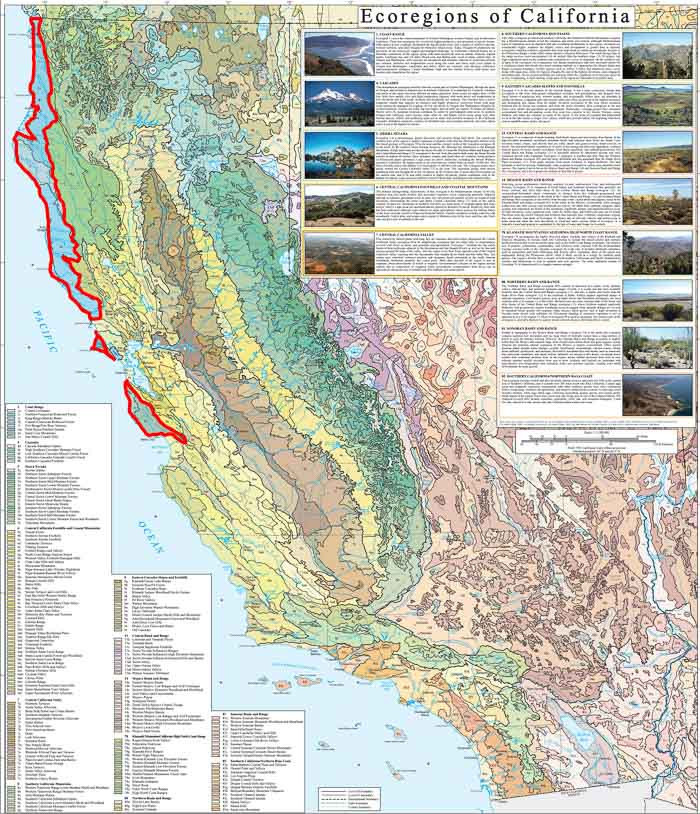About 25 percent of the plant species native to North America are at risk of extinction. You can help reverse this trend by planting great native plants in your garden.
California has tremendous ecological and biological diversity. It contains offshore islands and coastal lowlands, large alluvial valleys, forested mountain ranges, deserts, and various aquatic habitats.
California is divided into 13 main ecological regions and 177 sub-regions. Unique in topography, soil depth, pH, elevation, light, and hydrology, each region provides a rich variety of ecological habitats, supporting many native plant species.
The Northern California Coast region encompasses:
The climate in the North Coast Ecoregion is dominated by the marine influence of the Pacific Ocean. Temperatures average between 50-55ºF. Summer daytime temperatures are often modified by fog and sea breezes. Precipitation ranges from 40 to 100 inches. The growing season lasts 250 to 310 days.
The Northern California Coast region lies in Climate Zones 4, 7, 15, and 17.
Six counties make up the North Coast Ecoregion: Del Norte, Humboldt, Mendocino, Sonoma, San Mateo, and Santa Cruz Counties. The largest towns are Crescent City, Eureka, Arcata, and Fort Bragg.

According to the U.S. Forest Service, Invasive species have contributed to the decline of 42% of U.S. endangered and threatened species, and 18% of U.S. endangered or threatened species. Invasive species compete directly with native species for moisture, sunlight, nutrients, and space. They displace and alter native plant communities, degrade wildlife habitat and water quality, and potentially lead to increased soil erosion.
The federal government has estimated that nearly 25 percent of the 20,000 plant species native to North America are at risk of extinction, many of these through habitat loss. You can help reverse this trend by planting great native plants in your garden.
A plant is considered native if it has occurred naturally in a particular region or ecosystem without human introduction. There are many benefits to growing native plants.
Here is a list of California native shrubs that are well-suited for plantings in sunny gardens of the Northern California Coast Region.
| Climate Zones | 4, 7, 15, 17 |
|---|---|
| Plant Type | Shrubs |
| Exposure | Full Sun |
| Native Plants | United States, California |
123rf
| Climate Zones | 4, 7, 15, 17 |
|---|---|
| Plant Type | Shrubs |
| Exposure | Full Sun |
| Native Plants | United States, California |
Create a membership account to save your garden designs and to view them on any device.
Becoming a contributing member of Gardenia is easy and can be done in just a few minutes. If you provide us with your name, email address and the payment of a modest $25 annual membership fee, you will become a full member, enabling you to design and save up to 25 of your garden design ideas.
Join now and start creating your dream garden!
Create a membership account to save your garden designs and to view them on any device.
Becoming a contributing member of Gardenia is easy and can be done in just a few minutes. If you provide us with your name, email address and the payment of a modest $25 annual membership fee, you will become a full member, enabling you to design and save up to 25 of your garden design ideas.
Join now and start creating your dream garden!